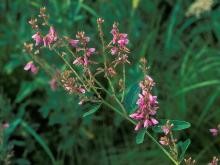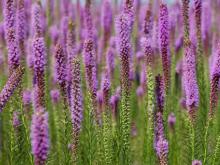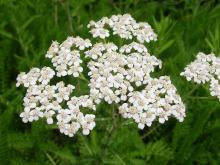Wildflowers, Grasses and Other Nonwoody Plants
Media

Species Types
Scientific Name
Claytonia virginica
Description
Our most widely distributed early spring flower, spring beauty has 5 white or pink petals with distinct pink veining, and 5 pink anthers. The narrow, bladelike leaves are fleshy. These flowers often grow in abundance, covering a patch of ground with the beauty of spring.
Media

Species Types
Scientific Name
Liatris aspera
Description
Rough blazing star is fairly common and scattered nearly statewide. To distinguish between Missouri’s nine species in the genus Liatris, start by noting details of the flower structure. It’s not hard when you know what to look for.
Media

Species Types
Scientific Name
Asclepias purpurascens
Description
The flowers of purple milkweed are pale purple to reddish purple to dark purple, with greenish or red tints. The scientific name means “becoming purple”: The flowers start off rather pale and become more intensely purplish as they mature.
Media

Species Types
Scientific Name
Apocynum cannabinum
Description
Indian hemp is a shrubby, upright perennial with opposite branches and milky sap. This native plant can be a troublesome weed in crop fields and gardens, but Native Americans used its tough, fibrous stems for rope-making.
Media

Species Types
Scientific Name
Symphyotrichum pilosum (formerly Aster pilosus)
Description
White heath aster is one of Missouri's most widespread and weedy native asters. It grows in uplands, bottomlands, and nearly all habitats in between. It has a shrubby, wide-branching habit, and the stem leaves are thin and needlelike.
Media

Species Types
Scientific Name
Blephilia ciliata
Description
Square, unbranching stems, opposite leaves, two-lipped flowers, and a mild minty fragrance are clues Ohio horsemint is in the mint family. Tight, rounded flower clusters are stacked atop one another at the stem tips.
Media

Species Types
Scientific Name
Desmodium spp. (17 species in Missouri)
Description
Missouri has 17 species of tick trefoils, which live in a variety of habitats. Hikers know them well from their chains of hairy little seedpods that stick to clothing like parasites!
Media

Species Types
Scientific Name
Liatris pycnostachya
Description
Prairie blazing star has an unbranched stalk with many densely crowded, rose-purple flowerheads. It is a signature wildflower of the tallgrass prairie.
Media

Species Types
Scientific Name
Agalinis tenuifolia (formerly Gerardia tenuifolia)
Description
Slender false foxglove, or common gerardia, is a small, showy wildflower with slender, opposite leaves and thin, wiry, branching stems. The small, funnel-shaped blossoms are pink or purple, with an upper lip that arches over the 4 hairy stamens.
Media

Species Types
Scientific Name
Achillea millefolium
Description
Native to North America, Europe, and Asia, yarrow has been used for medicine and magic for millennia. This aromatic plant has fine, hairy, fernlike leaves and flat-topped clusters of little white flowers.
See Also
About Wildflowers, Grasses and Other Nonwoody Plants in Missouri
A very simple way of thinking about the green world is to divide the vascular plants into two groups: woody and nonwoody (or herbaceous). But this is an artificial division; many plant families include some species that are woody and some that are not. The diversity of nonwoody vascular plants is staggering! Think of all the ferns, grasses, sedges, lilies, peas, sunflowers, nightshades, milkweeds, mustards, mints, and mallows — weeds and wildflowers — and many more!





















